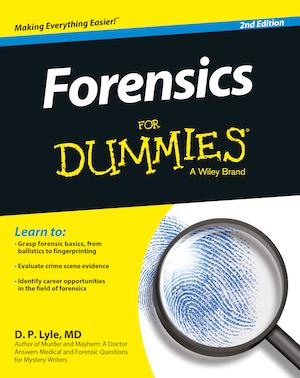The cornerstone of forensic science is known as the Locard Exchange Principle. Edmond Locard (1877-1966) studied and developed his investigative skills under the great forensic pioneer Alexandre Lacassagne and later headed the forensic laboratory in Lyon, France. His observations led him to conclude that criminals always left traces of themselves at crime scenes. And took evidence away when they departed. This became the foundation of his exchange principle.

FROM FORENSICS FOR DUMMIES, 2nd EDITION:
The Cornerstone of Forensic Science: Locard's Exchange Principle Every contact you make with another person, place, or object results in an exchange of physical materials. If you own a pet, this material exchange is well known to you. Look at your clothes and you're likely to see cat or dog hair clinging to the fabric-a pain in the behind if you want to keep your clothes looking sharp, but an incredible boon for forensic science. You may also find that you transfer these hairs to your car, your office, and any other place you frequent. Known as the Locard Exchange Principle, after Dr. Edmond Locard, the French police officer who first noticed it, the exchange of materials is the basis of modern forensic investigation. Using this principle, forensic scientists can determine where a suspect has been by analyzing trace evidence (any small piece of evidence), such as fibers on clothing, hair in a car, or gunk on the soles of shoes. Looking at Locard's principle in action: As an example, say that you have two children and a cat. You run out to take care of some errands that include stopping at a furniture store, the laundry, and the house of a friend who has one child and a dog. From a forensic science standpoint, this sequence of events can provide a gold mine of information. You leave behind a little bit of yourself at each stop, including * Hair from yourself, your children, and your cat * Fibers from your clothing and the carpets and furniture in your home and car * Fingerprints and shoe prints * Dirt and plant matter from your shoes * Biological materials, if you accidentally cut yourself and leave a drop of blood on the floor or sneeze into a tissue and then drop it in a trash can But that's not all. You also pick up similar materials everywhere you go: * Fibers from each sofa or chair you sat on at the furniture store ride away on your clothes, as do hair and fibers left behind by customers who sat there before you. * Fibers of all types flow through the air and ventilation system and settle on each customer at the laundry. * Hair from your friend, her child, and her dog latch on to you as do fibers from your friend's carpet and furniture. * Fibers, hairs, dirt, dust, plant material, and gravel are collected by your shoes and pants everywhere you set foot. In short, by merely running errands, you become a walking trace evidence factory.Today, many crimes have at least some cyber component-cell phones, computers, e mails. text messages, etc. Does the cyber world also have such a cyber exchange principle? Yes it does and it's actually quite extensive.
Forensic Magazine article: http://www.forensicmag.com/articles/2011/12/digital-forensics-cyber-exchange-principle#.UtFmzHn4VTE
